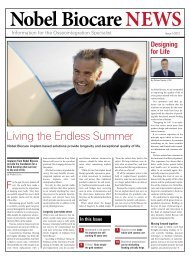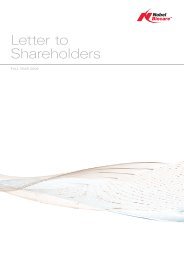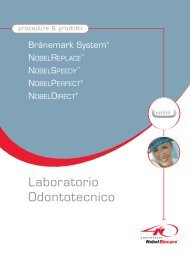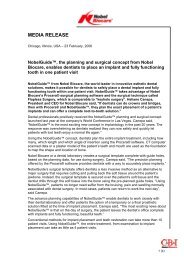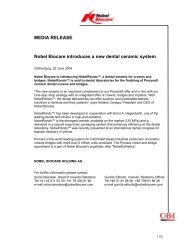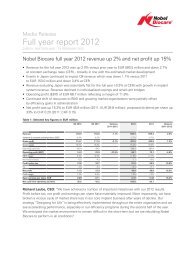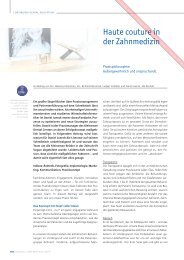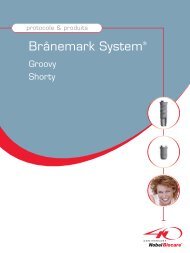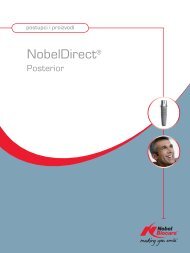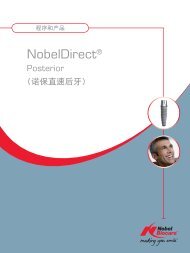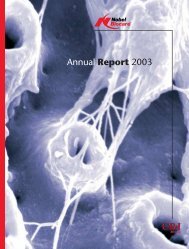All-in-One Procera Implant Bridge (PIB) versus ... - Nobel Biocare
All-in-One Procera Implant Bridge (PIB) versus ... - Nobel Biocare
All-in-One Procera Implant Bridge (PIB) versus ... - Nobel Biocare
You also want an ePaper? Increase the reach of your titles
YUMPU automatically turns print PDFs into web optimized ePapers that Google loves.
Materials and equipment<br />
Figure 2: Three implant level fits at 20 times magnification of a 14-unit seven implant <strong>PIB</strong><br />
responsibility — just tell me what to do!<br />
I can hear the crunch of pliers, the<br />
bang of a hammer, all to deliver yet<br />
another passive substructure. After all<br />
this, Wirz et al concluded, ‘Soldered<br />
jo<strong>in</strong>ts are described as hav<strong>in</strong>g a clear<br />
reduction <strong>in</strong> corrosion resistance, not<br />
to mention tissue irritation.’ (And so<br />
will lead to fracture, due to elements<br />
<strong>in</strong> solders that help to reduce the<br />
temperature.) At the time, it was all we<br />
had, and it still has its place <strong>in</strong> modern<br />
dentistry today.<br />
Technicians lived, and technicians<br />
retired and died. There were those<br />
who could solder <strong>in</strong> this way and<br />
who thought it was good. There were<br />
those who were not so good at it and<br />
who looked for other ways, so that<br />
they didn’t have to do it any more.<br />
Treatment plans changed, as did<br />
techniques; and so the seed was sown.<br />
These were difficult times for those who<br />
knew not how.<br />
The birth of laser-weld<strong>in</strong>g<br />
Then came the birth of ‘titanium’ <strong>in</strong><br />
everyday dentistry. Now, not only could<br />
the <strong>in</strong>attentive and under-tra<strong>in</strong>ed not<br />
solder, but neither could the skilled!<br />
The race was on to solve the titanium<br />
solder<strong>in</strong>g problem. In a flash, ‘laserweld<strong>in</strong>g’<br />
followed, heal<strong>in</strong>g all wounds.<br />
An <strong>in</strong>tense heat source heats just the<br />
area that needs melt<strong>in</strong>g together to the<br />
maximum depth of 1.5mm (an average<br />
connecter on a bridge should be 3mm).<br />
Technicians were happy aga<strong>in</strong> because:<br />
• There were no more <strong>in</strong>vestment<br />
models<br />
• It was direct on the model<br />
• There was no more flux<br />
• It was quick.<br />
Although it is always unrealistic to<br />
expect perfection, I was surprised when<br />
I read a recent article on laser/phaserweld<strong>in</strong>g,<br />
(Lighten<strong>in</strong>g <strong>in</strong> a Bottle by<br />
Joachim Mosch, Andreas Hoffman and<br />
Michael Hopp), <strong>in</strong> which they make<br />
the assertion that, ‘This development<br />
can actually be considered one of the<br />
major breakthroughs (advancements) <strong>in</strong><br />
dental technology <strong>in</strong> the last 15 years.’<br />
They go on to say:<br />
• ‘Proper welded jo<strong>in</strong>ts will lead to a<br />
perfect passive fit’<br />
• ‘Consequently, the surface condition<br />
of the components to be welded (highly<br />
polished or sandblasted) will <strong>in</strong>fluence<br />
the effect of the laser energy. The<br />
sh<strong>in</strong>ier the surface the less effective the<br />
laser will be, as more of the light energy<br />
hitt<strong>in</strong>g the object will be reflected away,<br />
reduc<strong>in</strong>g the ‘melt<strong>in</strong>g’ effect’<br />
• ‘Laser-welders typically need service<br />
and ma<strong>in</strong>tenance once a year, and a<br />
new laser lamp, every three years’<br />
• ‘In a laser-welder, the argon gas needs<br />
to be adjusted almost every time before<br />
weld<strong>in</strong>g, and the position of the nozzle<br />
is often <strong>in</strong> the technician’s way’<br />
• ‘The energy needed to penetrate the<br />
1.5mm would overheat the alloy’<br />
• ‘Practically, distortion must also be<br />
considered. To avoid distortion dur<strong>in</strong>g<br />
the weld<strong>in</strong>g process, place the spots<br />
carefully’<br />
• ‘The bent bar at the top prevents<br />
distortion’.<br />
I stopped read<strong>in</strong>g at this po<strong>in</strong>t<br />
because it seemed to me that the<br />
overwhelm<strong>in</strong>g evidence po<strong>in</strong>ted to<br />
the fact that to produce a passive,<br />
complicated implant <strong>in</strong>tegral structure<br />
is but a dream. I personally saw a laserwelded<br />
implant bridge, where one of<br />
the fixtures was shy of the implant<br />
replica by 0.5mm. For me, laser-weld<strong>in</strong>g<br />
is not the answer. It can do th<strong>in</strong>gs that<br />
conventional solder<strong>in</strong>g sometimes<br />
cannot do, but it is still only as good as<br />
the technician who is us<strong>in</strong>g it. There is<br />
still a ‘melt<strong>in</strong>g pool’ contraction at the<br />
site of melt<strong>in</strong>g the metals. Depend<strong>in</strong>g<br />
on the user, and us<strong>in</strong>g conventional<br />
solder<strong>in</strong>g, this can be larger than a<br />
precision-soldered jo<strong>in</strong> at 0.2mm.<br />
After study<strong>in</strong>g articles, and try<strong>in</strong>g the<br />
process myself, I f<strong>in</strong>d laser-weld<strong>in</strong>g has<br />
more applications than conventional<br />
solder<strong>in</strong>g, but I do th<strong>in</strong>k that <strong>in</strong><br />
conventional work, when repair<strong>in</strong>g<br />
holes <strong>in</strong> cast<strong>in</strong>gs, the time taken to<br />
re-wax and add the new unit <strong>in</strong>to the<br />
Private Dentistry October 2008 105



